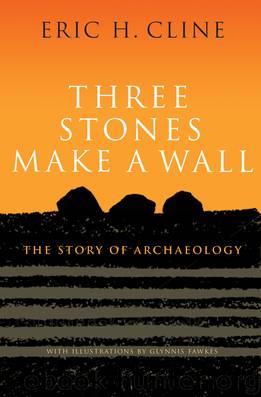Three Stones Make a Wall: The Story of Archaeology by Cline Eric H

Author:Cline, Eric H. [Cline, Eric H.]
Language: eng
Format: epub
ISBN: 9780691166407
Publisher: Princeton University Press
Published: 2016-12-20T07:00:00+00:00
The archaeologists found other caves in the region of the Dead Sea that had remnants of scrolls and ancient writing, as well as other objects, but they are probably unrelated to the main body of the Dead Sea Scrolls, since the remains found in them are from other periods.
One of the best known is a cave in a wadi, or canyon or valley, called Nahal Mishmar. In what is now known as the Cave of the Treasure, archaeologists found a tremendous hoard of about four hundred copper objects dating to the Chalcolithic period, about 3500 BCE. A number of them were maceheads, more likely ceremonial than functional; others look like crowns and scepters, though it is not clear whether this is how they were actually used.
Two other caves are even more famous. Located in a wadi called Nahal Hever, which is about twenty-five miles south of Qumran, they are called the Cave of Horrors and the Cave of Letters. One is located in the cliff face that makes up the northern side of the wadi, the other is in a similar location on the southern side. Both had a Roman siege camp built on the top of the cliff directly above them and both are on such a steep slope that it is best to reach them now by precarious rope ladders.
Both caves were first discovered in 1953, but were not truly investigated and excavated until 1960 and 1961, as part of an effort by teams led by four distinguished Israeli archaeologists, including Yadin.
The first one, the Cave of Horrors, is called that because of the grisly discoveries that the archaeologists made in there. They found forty skeletons in the cave, all dating to the time of the Second Jewish Revolt against Roman rule, known as the Bar Kokhba Revolt. The rebellion lasted from 132 to 135 CE and was unsuccessful. The bodies found in this cave are thought to have been refugees or rebels who were unable to get out or escape from the cave because of the Romans camped directly above them, no doubt very deliberately. They may well have starved to death, since there was no evidence of trauma, but we may never know the real story of what happened in the Cave of Horrors.
In contrast, we know an amazing amount about the Cave of Letters. Yadin was in charge of exploring this cave in 1960 and 1961, although it had already been fairly thoroughly examined by archaeologists in 1953. It turned out to be extremely rich, with finds from three periods. One period was the Chalcolithic, from about 3500 BCE, contemporary with the Cave of the Treasure in Nahal Mishmar. A second period was the first century CE, perhaps during the time of the First Jewish Revolt when all the scrolls had been hidden in the caves closer to Qumran. The third period was the second century CE—that is, the time of the Second Jewish Revolt.
The cave has two narrow entrances, both leading into what is called Hall A.
Download
This site does not store any files on its server. We only index and link to content provided by other sites. Please contact the content providers to delete copyright contents if any and email us, we'll remove relevant links or contents immediately.
The Daily Stoic by Holiday Ryan & Hanselman Stephen(3230)
The Fate of Rome: Climate, Disease, and the End of an Empire (The Princeton History of the Ancient World) by Kyle Harper(3003)
People of the Earth: An Introduction to World Prehistory by Dr. Brian Fagan & Nadia Durrani(2701)
Ancient Worlds by Michael Scott(2622)
Babylon's Ark by Lawrence Anthony(2620)
The Daily Stoic by Ryan Holiday & Stephen Hanselman(2459)
Foreign Devils on the Silk Road: The Search for the Lost Treasures of Central Asia by Peter Hopkirk(2433)
India's Ancient Past by R.S. Sharma(2416)
MOSES THE EGYPTIAN by Jan Assmann(2372)
The Complete Dead Sea Scrolls in English (7th Edition) (Penguin Classics) by Geza Vermes(2234)
Lost Technologies of Ancient Egypt by Christopher Dunn(2194)
The Earth Chronicles Handbook by Zecharia Sitchin(2179)
24 Hours in Ancient Rome by Philip Matyszak(2049)
Alexander the Great by Philip Freeman(2032)
Aztec by Gary Jennings(1975)
The Nine Waves of Creation by Carl Johan Calleman(1884)
Curse Tablets and Binding Spells from the Ancient World by Gager John G.;(1838)
Before Atlantis by Frank Joseph(1810)
Earthmare: The Lost Book of Wars by Cergat(1790)
